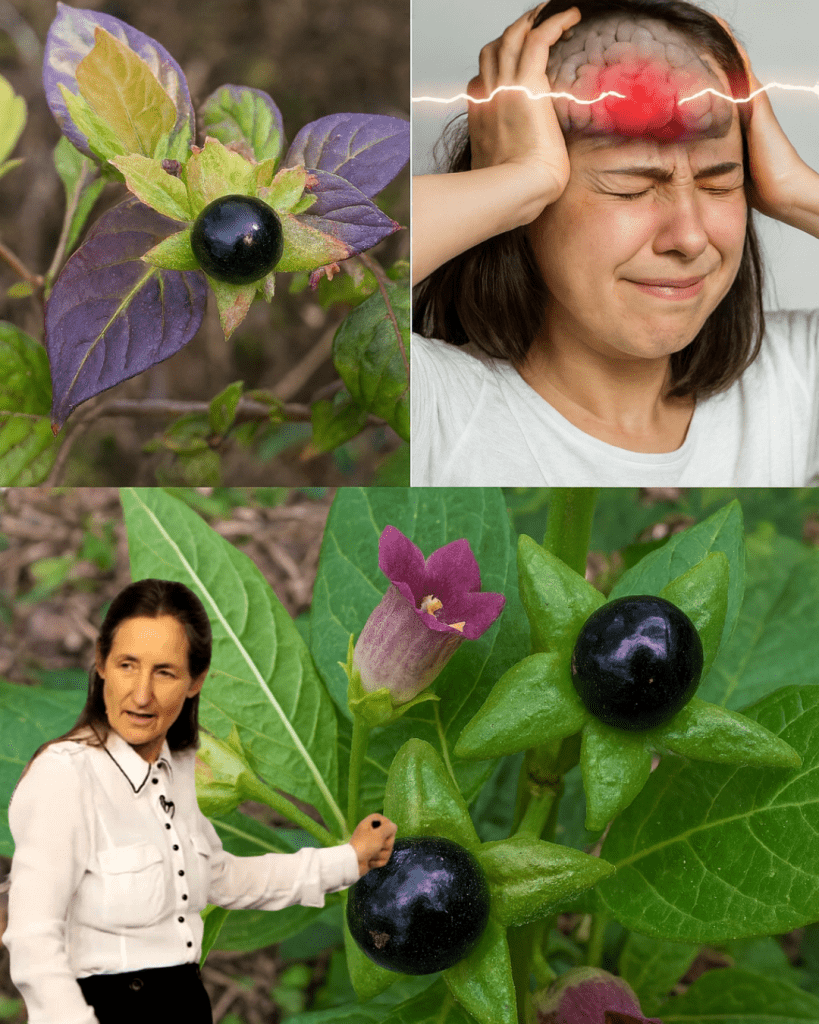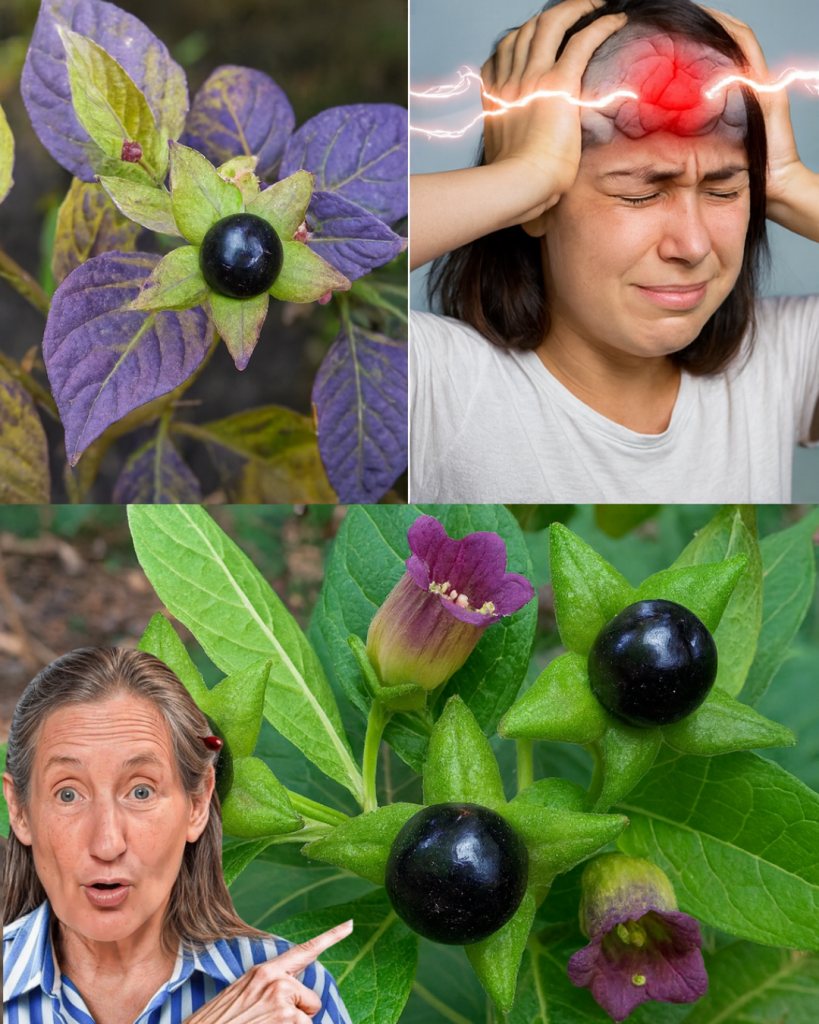What if a plant so beautiful it was named “beautiful lady” could also be a silent killer? Atropa belladonna, or Deadly Nightshade, is a botanical enigma, its glossy black berries and delicate purple flowers hiding a toxic legacy steeped in poison, witchcraft, and forbidden beauty. Revered in history for its seductive charm and feared for its deadly alkaloids, this plant has left an indelible mark from ancient Rome to modern medicine. With a narrow line between healing and harm, Deadly Nightshade captivates and cautions in equal measure. Ready to explore its dangerous allure, historical significance, and why it demands respect? Dive into this guide to uncover the mysteries of this infamous plant and learn how to stay safe in its presence.

🌿 What Is Deadly Nightshade?
A member of the Solanaceae family, alongside tomatoes and potatoes, Atropa belladonna thrives in the shaded woodlands of Europe, North Africa, and Western Asia. This herbaceous perennial grows up to 6 feet, boasting bell-shaped, purple flowers with a greenish tint, large, dark green leaves, and tempting, glossy black berries. Every part—leaves, stems, roots, and berries—is laden with potent alkaloids, making it one of the most toxic plants known. Its beauty belies a dark reputation, earning it names like “devil’s berries” and a place in history’s most sinister tales.
☠️ The Toxic Power Within
The danger of Deadly Nightshade lies in its trio of alkaloids: atropine, scopolamine, and hyoscyamine. These compounds disrupt the nervous system, blocking neurotransmitters and triggering severe symptoms.
🧠 Atropine
Causes hallucinations, rapid heartbeat, and, in high doses, paralysis. Even small amounts can lead to life-threatening poisoning.
😵 Scopolamine
Known for inducing dizziness, confusion, and altered consciousness, it’s historically been used as a poison or sedative.
💀 Hyoscyamine
Interferes with neurological functions, potentially causing convulsions or death if overconsumed.
These alkaloids create a narrow therapeutic window—tiny doses may heal, but slight excess can kill. Symptoms range from dry mouth and blurred vision to delirium, respiratory failure, and coma, making Deadly Nightshade a plant to fear without expert handling.
📜 A Dark and Fascinating History
Deadly Nightshade has woven itself into human history, blending beauty, danger, and medicine in equal parts.
🏛️ Ancient Rome and Greece
Poisoners and assassins used its extracts to tip arrows or eliminate rivals, leveraging its lethal potency for silent kills.
🧙♀️ Medieval Witchcraft
Linked to sorcery, belladonna was a key ingredient in “flying ointments,” believed to induce hallucinations and mystical experiences during rituals.
💄 Renaissance Beauty
Italian women used diluted extracts to dilate pupils, creating a sultry, wide-eyed look—hence “belladonna” (beautiful lady). This risky practice often led to vision damage or poisoning.
💉 Modern Medicine
Today, controlled extracts are used in ophthalmology for pupil dilation, muscle relaxants for spasms, and scopolamine patches for motion sickness. Atropine even serves as an antidote for nerve gas poisoning, showcasing the plant’s dual nature when handled by professionals.
🚨 Symptoms of Poisoning
Even a small nibble of Deadly Nightshade can be fatal, with symptoms appearing within 20-60 minutes and lasting hours or days.
😓 Mild Symptoms
Dry mouth, dilated pupils, blurred vision, rapid heartbeat, confusion, and dizziness signal early exposure.
😵 Severe Symptoms
Hallucinations, delirium, convulsions, and difficulty breathing indicate serious poisoning.
💀 Fatal Outcomes
In extreme cases, complete paralysis and respiratory failure can lead to death without swift intervention.
🧒 Who’s Most at Risk?
Certain groups face higher dangers:
- Children: Sweet-looking berries tempt young explorers, but just 2-5 can be fatal.
- Pets and Livestock: Dogs, cats, and cattle risk poisoning from grazing on the plant.
- Foragers and Herbalists: Misidentification during wild harvesting can lead to accidental exposure.
🩺 Can It Be Used Safely?
In controlled medical settings, Deadly Nightshade’s alkaloids are harnessed for:
- Eye Exams: Atropine dilates pupils for diagnostic procedures.
- Muscle Spasms: Hyoscyamine relaxes muscles in conditions like Parkinson’s.
- Motion Sickness: Scopolamine patches prevent nausea during travel.
- Emergency Care: Atropine counters nerve gas or pesticide poisoning.
However, self-medication is never safe. The plant’s toxicity far outweighs benefits without professional oversight.
🔍 How to Identify Deadly Nightshade
Avoid accidental exposure by recognizing its traits:
- Flowers: Purple, bell-shaped with a greenish hue.
- Berries: Shiny, black, and deceptively cherry-like.
- Leaves: Large, oval, dark green, and slightly glossy.
- Height: Grows 3-6 feet with a bushy appearance.
When foraging, use a plant identification app or consult an expert to avoid mistaking it for edible berries.
🌳 Should You Grow It?
Deadly Nightshade can be grown ornamentally or for research, but extreme caution is needed:
- Gardens: Fence off or label clearly to keep children and pets away.
- Medicinal Use: Leave to professionals, as home extraction is dangerous.

💬 A Tale of Caution and Wonder
A friend’s brush with belladonna while foraging taught us its power. Mistaking its berries for edible fruit, she experienced dizziness and blurred vision before seeking help. Her recovery, thanks to quick medical care, was a stark reminder of the plant’s danger—and its mystique. This encounter inspired us to respect its legacy while steering clear of its risks.
🧠 Tips for Staying Safe
- Learn Identification: Study its features or use a guidebook to avoid confusion with safe plants.
- Wear Gloves: If handling, protect skin from alkaloid absorption.
- Educate Others: Warn family about its berries, especially in rural areas.
- Seek Help Fast: If exposure occurs, call Poison Control (1-800-222-1222) or 911 immediately.
🌍 A Legacy of Beauty and Danger
From Roman poisons to Renaissance beauty rituals, Deadly Nightshade has shaped history with its dual nature. Its name, tied to the Greek fate Atropos who cuts life’s thread, reflects its lethal power. Yet, its controlled use in modern medicine highlights nature’s complex balance of harm and healing.
✨ Respect the Power of Deadly Nightshade
Atropa belladonna is a plant of paradox—stunning yet deadly, medicinal yet dangerous. Its dark legacy captivates, but its toxicity demands caution. Whether you’re a gardener, forager, or history buff, respect its potency and avoid casual use. Share this knowledge to keep others safe, and explore more natural remedies on our site to harness nature’s safer gifts. Have a belladonna story or tip? Drop it in the comments below—let’s keep the conversation alive!
Disclaimer: This article is for informational purposes only and does not substitute professional medical advice. Consult your doctor before handling or using any part of Deadly Nightshade.









